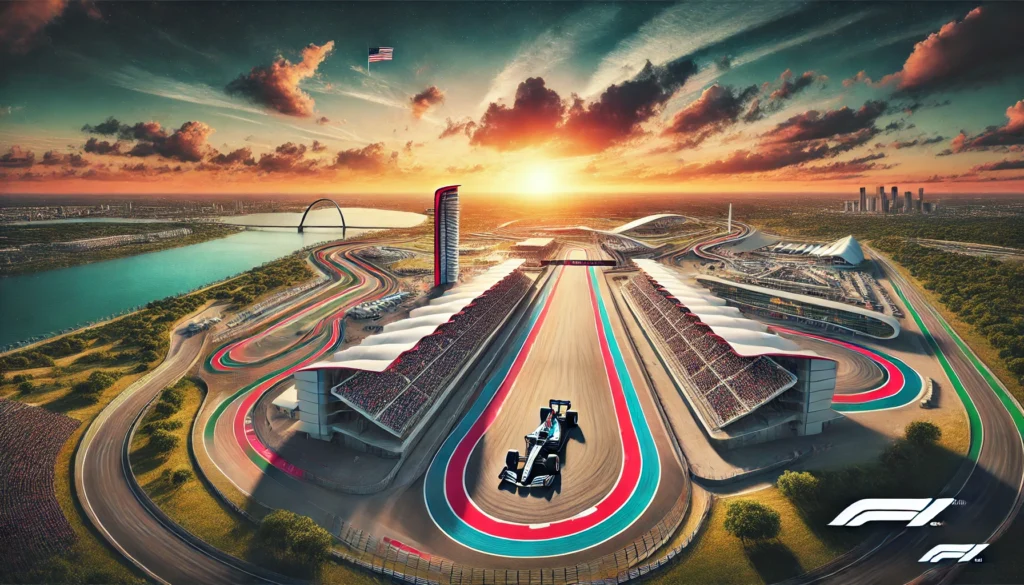The United States has witnessed a surge in Formula 1 enthusiasm, fueled by popular media and an expanding race calendar. As the sport’s American footprint grows, let’s revisit the circuits that have shaped F1’s stateside story, evaluating them based on their historical significance, impact on the sport, and racing quality.
1. Circuit of The Americas (COTA) – Austin, Texas
- Debut: 2012
- Highlight: Lewis Hamilton’s inaugural victory
COTA stands as the modern epicenter of American F1 racing. Its challenging layout, featuring the iconic uphill Turn 1, has quickly earned it favor among drivers and fans alike. The circuit’s blend of long straights and technical sections consistently delivers exciting races, cementing Austin’s place as a premier F1 destination.

2. Indianapolis Motor Speedway – Indianapolis, Indiana
- F1 Debut: 2000 (Hosted until 2007)
- Highlight: Michael Schumacher’s early 2000s dominance
The legendary Indy 500 venue adapted its layout for F1, combining oval racing with a technical infield section. While its F1 tenure was relatively short and marred by the controversial 2005 race, Indianapolis’s grandeur and unique racing dynamics left an indelible mark on the sport’s American chapter.
3. Miami International Autodrome – Miami, Florida
- Debut: 2022
- Highlight: Max Verstappen’s inaugural race victory
As one of F1’s newest venues, the Miami circuit has quickly established itself as a glamorous addition to the calendar. Set around the Hard Rock Stadium, it offers a mix of speed and technicality that promises exciting racing for years to come.
4. Watkins Glen International – Watkins Glen, New York
- F1 Era: 1961-1980
- Highlight: James Hunt’s thrilling 1976 win
“The Glen” was America’s F1 heartland for two decades. Its fast, flowing nature and challenging elevation changes made it a driver favorite. Despite its eventual departure from the calendar due to financial and safety concerns, Watkins Glen remains a beloved part of F1’s American legacy.
5. Caesars Palace – Las Vegas, Nevada
- F1 Years: 1981-1982
- Highlight: Alan Jones winning the inaugural event
This unique, albeit short-lived, venture brought F1 to the Las Vegas Strip. While the parking lot circuit was unpopular with drivers, it represented an ambitious attempt to merge F1 with Vegas spectacle, earning it a quirky place in racing history.
6. Sebring International Raceway – Sebring, Florida
- F1 Appearance: 1959
- Highlight: Bruce McLaren’s victory in the sole F1 race
Though better known for endurance racing, Sebring’s one-off F1 event marked the sport’s U.S. debut. Its rough, challenging layout provided a unique test, even if it wasn’t deemed suitable for F1’s long-term plans.
7. Riverside International Raceway – Riverside, California
- F1 Race: 1960
- Highlight: Stirling Moss winning the only F1 race held there
Riverside’s brief F1 stint didn’t leave a lasting impression on the sport, but its fast straights and sweeping corners offered a taste of Southern California to the F1 world.
8. Dallas Fair Park – Dallas, Texas
- F1 Event: 1984
- Highlight: Keke Rosberg’s triumph in extreme heat
The one-off Dallas Grand Prix is remembered more for its challenges – extreme heat and a deteriorating track surface – than its racing. While ambitious, the event’s difficulties ensured F1 didn’t return to Dallas.
Looking Ahead
From COTA’s modern excellence to Watkins Glen’s historical significance, each of these circuits has contributed to F1’s American story. As new venues like Miami thrive and with Las Vegas on the horizon, F1’s U.S. future looks brighter than ever, building on a rich and varied history of American Grand Prix racing.



